Authored by Derrick Jackson & Co-Author Lisa Yu
Table of Contents
Most people think cloud certifications are just technical checkboxes. They’re wrong. The AWS Certified Solutions Architect – Associate certification stands out as the most widely held credential, with 54% of AWS professionals holding this specific certification, placing it far ahead of others like the Cloud Practitioner (37%) and Developer – Associate (25%).
Take any hiring manager in 2025. For entry-level cloud positions, the certification is often listed as a preferred qualification, while for mid-level and senior architect roles, it is frequently a de facto requirement. Data from various sources converges on an average annual salary range of approximately $125,000 to $155,000 USD for SAA-C03 holders. That’s not theoretical money. That’s real compensation backed by actual market demand.

As of early 2025, there were over 1.05 million unique individuals holding more than 1.42 million active AWS certifications globally. Within this massive ecosystem, the Solutions Architect – Associate doesn’t just validate technical skills. It opens doors to career opportunities that didn’t exist a decade ago.

The convergence of Artificial Intelligence and serverless computing is fundamentally reshaping the role of the Solutions Architect. The paradigm is shifting away from the manual provisioning and management of underlying infrastructure and toward the composition of high-level, managed services to deliver business outcomes. This makes the SAA-C03 more relevant, not less.
What’s the Deal with AWS Certified Solutions Architect – Associate?
The AWS Certified Solutions Architect – Associate (SAA-C03) isn’t just another tech certification. It validates an individual’s ability to design secure, resilient, high-performing, and cost-optimized solutions based on the AWS Well-Architected Framework. Amazon Web Services launched this credential to address a critical gap in the market: the need for professionals who can bridge business requirements with technical implementation.
The certification has evolved over time to reflect changes in the AWS platform and industry best practices. The original version, SAA-C01, was launched in February 2018. It was succeeded by SAA-C02 on March 23, 2020. The current version, SAA-C03, became available on August 30, 2022. Each iteration reflects AWS’s commitment to keeping pace with rapid cloud innovation.
What makes this certification different? Unlike vendor-neutral alternatives, it provides deep, practical knowledge of the world’s largest cloud platform. The SAA-C03 certification is designed to validate precisely this multifaceted skill set. It is consistently ranked among the most popular and valuable certifications in the IT industry, largely because it aligns directly with the core competencies that employers seek in cloud professionals.
The certification covers four core domains that mirror real-world architectural challenges. The evolution across these versions reveals a clear trend: an increasing emphasis on security, cost optimization, and resilience, mirroring the maturation of enterprise cloud adoption from experimental projects to business-critical operations.
Who Should Look Into This?
The SAA-C03 serves multiple audiences with different career trajectories. Understanding where you fit helps determine if this investment makes sense for your situation.
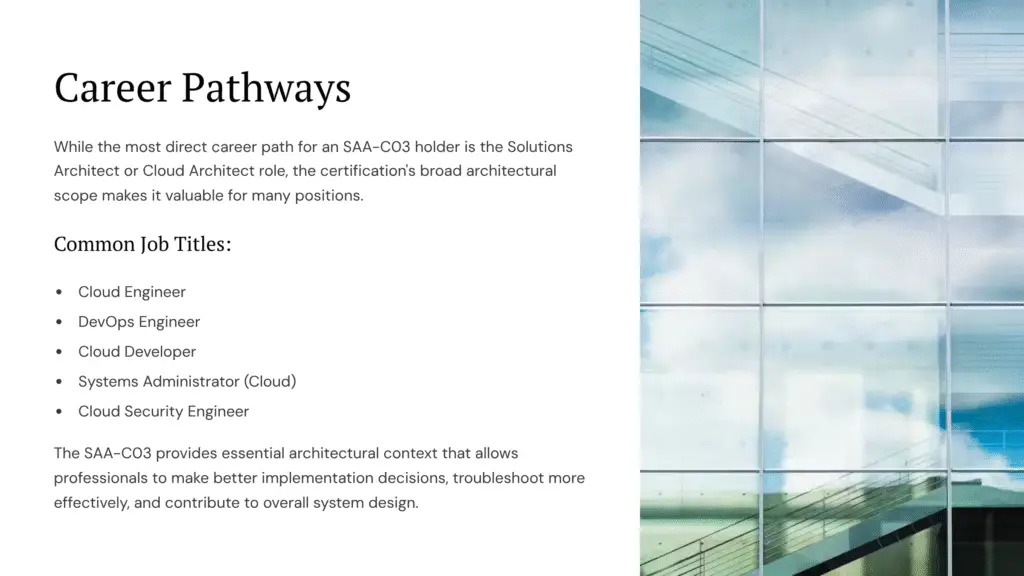
Experienced IT professionals transitioning to cloud. AWS officially defines the target candidate for the SAA-C03 exam as an individual with at least one year of hands-on experience in designing and implementing cloud solutions using a range of AWS services. These professionals already understand systems architecture but need cloud-specific knowledge.
Career changers with general IT background. AWS itself acknowledges that many candidates with 1 to 3 years of general IT experience—not necessarily cloud-specific—have successfully prepared for and earned this credential. Network administrators, system administrators, and software developers fall into this category.
New IT entrants seeking cloud careers. For individuals with no prior IT work experience, a clear and recommended pathway exists. The consensus, supported by official AWS guidance, is to first pursue the AWS Certified Cloud Practitioner (CLF-C01) certification. This foundational step establishes necessary cloud concepts before tackling architectural principles.
Business professionals in technical roles. Project managers, technical consultants, and solution architects working with cloud technologies benefit from formal validation of their knowledge. The knowledge of how AWS services interoperate to create secure, scalable, and cost-effective systems is foundational for many technical roles.
Current AWS practitioners seeking advancement. Its primary function in the hiring process is often as an initial filter. With a high volume of applicants for cloud roles, the certification provides recruiters with a quick and reliable way to verify a candidate’s baseline knowledge and commitment to the AWS platform. Without this certification, career progression becomes significantly more challenging.
The reality? Because the SAA-C03 is the most common AWS certification, its absence can be more detrimental than its presence is beneficial for competitive roles. It has become “table stakes”—an expected credential for any serious applicant aiming for an architect-track career in the AWS ecosystem.
4 Core Domains: What You Need to Master
The SAA-C03 exam is structured around four distinct but interconnected domains, each representing a core pillar of modern cloud architecture. Success on the exam requires not just isolated knowledge of AWS services but a holistic understanding of how to apply them to meet specific architectural requirements.
Domain 1: Design Secure Architectures (30%)
Security represents the largest portion of the exam for good reason. A central concept is the AWS Shared Responsibility Model, which defines the division of security responsibilities between AWS and the customer. A deep understanding of AWS Identity and Access Management (IAM) is non-negotiable. This includes mastering the use of IAM Users, Groups, Roles, and Policies to enforce the principle of least privilege.
Key services include AWS IAM, AWS IAM Identity Center, Security Groups, Network Access Control Lists (NACLs), AWS WAF, AWS Shield, AWS KMS, and AWS Secrets Manager. Data protection involves securing data both at rest and in transit. This requires knowledge of AWS Key Management Service (KMS) for creating and managing encryption keys, and AWS Certificate Manager (ACM) for provisioning and managing TLS certificates for secure transit.

Domain 2: Design Resilient Architectures (26%)
This domain focuses on building systems that can withstand component failure and recover quickly from disruptions. The core principle is designing for high availability and fault tolerance by leveraging the AWS Global Infrastructure, specifically the distinction between Regions and Availability Zones (AZs).
Critical technologies include Elastic Load Balancing (ELB) to distribute traffic across multiple targets and Amazon EC2 Auto Scaling to automatically adjust compute capacity. For databases, candidates must understand how to configure Amazon RDS in a Multi-AZ deployment for automatic failover. Data resilience is tested through knowledge of Amazon S3 features like versioning and replication for durability, as well as services like AWS Backup for centralized backup management.

Domain 3: Design High-Performing Architectures (24%)
Performance efficiency is about using computing resources effectively to meet system requirements and maintaining that efficiency as demand changes and technologies evolve. This involves choosing the right Amazon EC2 instance types (e.g., compute-optimized, memory-optimized), selecting appropriate Amazon EBS volume types (e.g., gp3 vs. io2 Block Express) for specific I/O needs, and understanding the use cases for different storage solutions like Amazon EFS for shared file storage and Amazon S3 for object storage.
Database performance requires understanding when to use Amazon RDS versus Amazon DynamoDB, and how to implement caching with Amazon ElastiCache. For global applications, knowledge of edge services is essential. This includes using Amazon CloudFront, a content delivery network (CDN), to cache content closer to users and reduce latency.
Domain 4: Design Cost-Optimized Architectures (20%)
A significant component of the SAA-C03 exam, this domain focuses on the ability to build and operate systems at the lowest possible price point without sacrificing other architectural pillars. Candidates must be proficient in choosing the most cost-effective EC2 pricing models, such as using Savings Plans or Reserved Instances for predictable workloads and Spot Instances for fault-tolerant, interruptible tasks.
Storage optimization requires knowledge of S3 Storage Tiers, including S3 Intelligent-Tiering for automatic cost optimization and Glacier for long-term archival. The exam also tests familiarity with AWS cost management tools. This includes using AWS Budgets to set custom cost and usage alerts and AWS Cost Explorer to visualize and analyze spending patterns.
What to Expect From the Exam
The SAA-C03 exam format reflects AWS’s commitment to testing practical architectural knowledge rather than memorization. The exam is administered globally by Pearson VUE and can be taken either at a designated testing center or through a secure online proctored environment, offering flexibility to candidates worldwide.
Exam Structure and Scoring
The exam’s scoring model is based on a scaled score ranging from 100 to 1,000, with a minimum passing score of 720. It employs a compensatory model, meaning a candidate’s final score is based on their overall performance across all domains; it is not necessary to achieve a passing score in each individual section. 65 questions must be completed within 130 minutes, featuring multiple choice and multiple response formats.
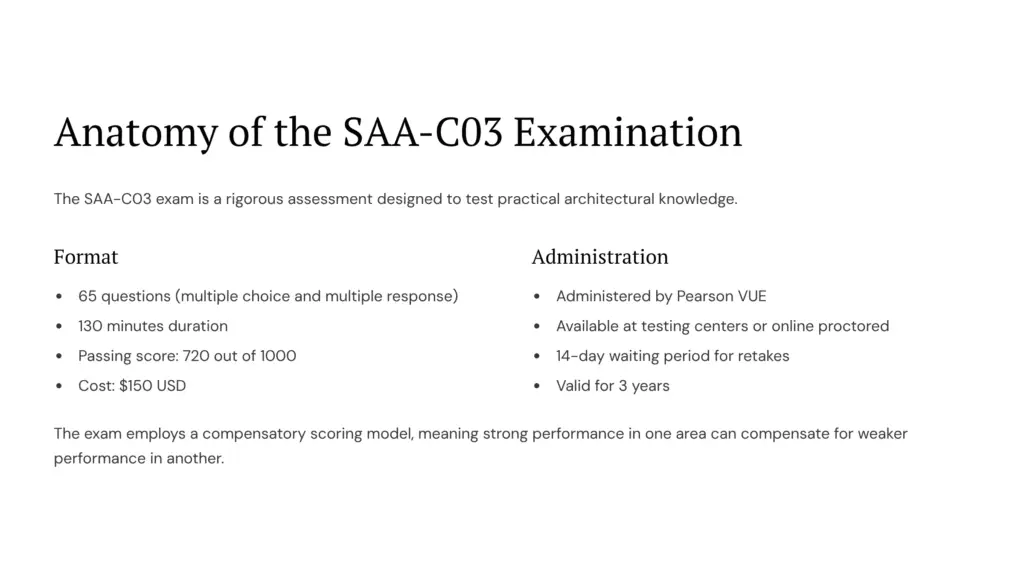
Cost and Logistics
The exam costs $150 USD, making it accessible compared to many professional certifications. If a candidate fails an exam, there is a mandatory 14-day waiting period before they are eligible for a retake. While there is no limit on the number of attempts, the full registration fee is required for each attempt.
Scheduling Flexibility
For scheduling, candidates have up to 24 hours before their appointment to cancel or reschedule without incurring additional fees. This policy accommodates unexpected conflicts while maintaining exam integrity.
Certification Validity
The AWS Certified Solutions Architect – Associate certification is valid for three years from the date it is earned. This policy ensures that certified professionals remain current with the rapid pace of innovation on the AWS platform. There are two strategic pathways for recertification. The first option is to pass the latest version of the AWS Certified Solutions Architect – Associate exam. The second, more advanced option is to pass the AWS Certified Solutions Architect – Professional (SAP) exam.
Career Impact and Salary Expectations
The financial return on SAA-C03 certification is substantial and well-documented across multiple salary surveys. For entry-level to mid-level roles (approximately 0-5 years of relevant experience), professionals holding the SAA-C03 can expect to earn a competitive salary. Data from various sources converges on an average annual salary range of approximately $125,000 to $155,000 USD.
Entry-Level Opportunities ($125,000 – $145,000)
Recent graduates and career changers typically start as Junior Cloud Engineers, Associate Solutions Architects, or Cloud Support specialists. A 2025 Skillsoft report lists the average salary for SAA-C03 holders in the United States at $155,597, while other platforms like ZipRecruiter and DataCamp report averages in the mid-$140,000s. Geographic location significantly impacts these figures.
Mid-Level Positions ($140,000 – $165,000)
With 3-5 years of experience, professionals advance to Cloud Engineer, Solutions Architect, and DevOps Engineer roles. Additional skills in automation, containerization, and Infrastructure as Code command premium compensation.
Senior-Level Roles ($160,000+)
For experienced professionals (5+ years), salaries can extend well beyond this range, often exceeding $150,000 and approaching $200,000 or more, particularly for those who advance to the Professional-level certification. Geographic location is another major factor, with top-tier tech hubs offering significant premiums. Cities in California (such as Berkeley, Sunnyvale, and San Francisco) and other high-cost-of-living areas often feature the highest salaries for architect roles, with averages potentially exceeding $170,000.
The Certification as a “Skill Multiplier”
It is crucial to recognize that the certification acts as a “skill multiplier.” The wide variance in reported salaries reflects the diverse backgrounds of certified individuals. A professional with a decade of network engineering experience who earns the SAA-C03 will command a salary at the higher end of the spectrum, while a recent entrant to the IT field will likely start at the lower end.
Market Demand Context
The U.S. Bureau of Labor Statistics projects that overall employment in computer and information technology occupations will grow significantly faster than the average for all other occupations between 2023 and 2033. The report specifically identifies cloud computing as a key driver of this growth, with roles such as computer network architects being in high demand.
Prerequisites and Experience Requirements
AWS maintains realistic expectations for SAA-C03 candidates while acknowledging diverse pathways to certification. AWS officially defines the target candidate for the SAA-C03 exam as an individual with at least one year of hands-on experience in designing and implementing cloud solutions using a range of AWS services. This profile suggests a professional who is already familiar with the practical challenges of building on the cloud.
Official Prerequisites
The good news? No formal prerequisites exist for the SAA-C03 exam. However, AWS recommends the AWS Certified Cloud Practitioner (CLF-C01) certification for newcomers. This foundational certification establishes essential cloud vocabulary and concepts.
Recommended Background
AWS itself acknowledges that many candidates with 1 to 3 years of general IT experience—not necessarily cloud-specific—have successfully prepared for and earned this credential. This indicates a strategic positioning of the SAA-C03 as both a validation for existing practitioners and a primary gateway for new talent to enter the cloud workforce.
Alternative Pathways
Professionals from various technical backgrounds can successfully pursue this certification:
- Network administrators familiar with routing and security concepts
- System administrators experienced with server management
- Software developers understanding application architecture
- Database administrators with data management experience
Timeline Expectations
Study time varies significantly based on background. Professionals with strong IT fundamentals typically require 3-6 months of dedicated preparation. Those newer to technology may need 6-12 months to build both foundational knowledge and AWS-specific expertise.
The certification’s broad appeal stems from its practical focus. This dual role is a key factor in its widespread popularity, creating a diverse community of certified professionals with varied backgrounds in systems administration, software development, and network engineering.
Preparation Strategy: How to Actually Pass
Success on the SAA-C03 requires strategic preparation that combines conceptual understanding with hands-on experience. The preparation landscape is mature, offering a wealth of resources that cater to different learning styles and experience levels. A successful study plan involves a multi-layered strategy that combines official AWS materials for foundational knowledge, in-depth third-party courses for practical understanding, and rigorous practice exams for readiness assessment.
Foundation Phase: Official AWS Resources
The starting point for any candidate should be the official resources provided by AWS. These materials define the scope of the exam and offer authoritative guidance. Start with the Official Exam Guide, which outlines exam domains and specific knowledge requirements.
AWS Skill Builder provides free access to the “Exam Prep Plan” for SAA-C03. This plan includes digital courses, hands-on labs, and an Official Practice Question Set (a 20-question sampler) that helps candidates familiarize themselves with the style of the exam questions.
Deep-Dive Learning: Third-Party Courses
The most effective preparation strategy often involves selecting one primary video course and combining it with a high-quality practice exam suite. This approach has become a proven, community-vetted formula for success.
Two providers consistently receive community recommendations:
Adrian Cantrill’s course offers unmatched depth with extensive hands-on labs. Highly respected for creating genuine architects, not just certificate holders. Best for candidates seeking deep, foundational understanding who have more study time available.
Stéphane Maarek’s Udemy course provides concise, exam-focused content with clear explanations. The most frequently recommended course for its balance of depth and efficiency. Ideal for candidates needing a direct, time-efficient path with some prior IT knowledge.
Critical Phase: Practice Exams
The final and most critical phase of preparation is assessing exam readiness through high-quality practice tests. This step is indispensable for several reasons: it builds familiarity with the question format and time constraints, helps identify and remediate weak areas, and builds the confidence needed to perform well under pressure.
TutorialsDojo practice exams by Jon Bonso represent the gold standard. Its question banks are renowned for closely mirroring the difficulty, wording, and scenario-based nature of the actual SAA-C03 exam. Crucially, each question comes with a detailed explanation for both the correct and incorrect answers, often with links to official AWS documentation.
Study Timeline
A recommended multi-stage approach is as follows: Foundation and Scope (1-2 weeks): Begin by thoroughly reading the official SAA-C03 Exam Guide. Complete the free AWS Skill Builder digital courses and review the AWS Well-Architected Framework whitepaper to establish a solid conceptual foundation. Conceptual Learning and Hands-On Practice (6-10 weeks): Select and commit to a single, high-quality video course. Actively participate in all hands-on labs and demos, using the AWS Free Tier to build, experiment, and break things.
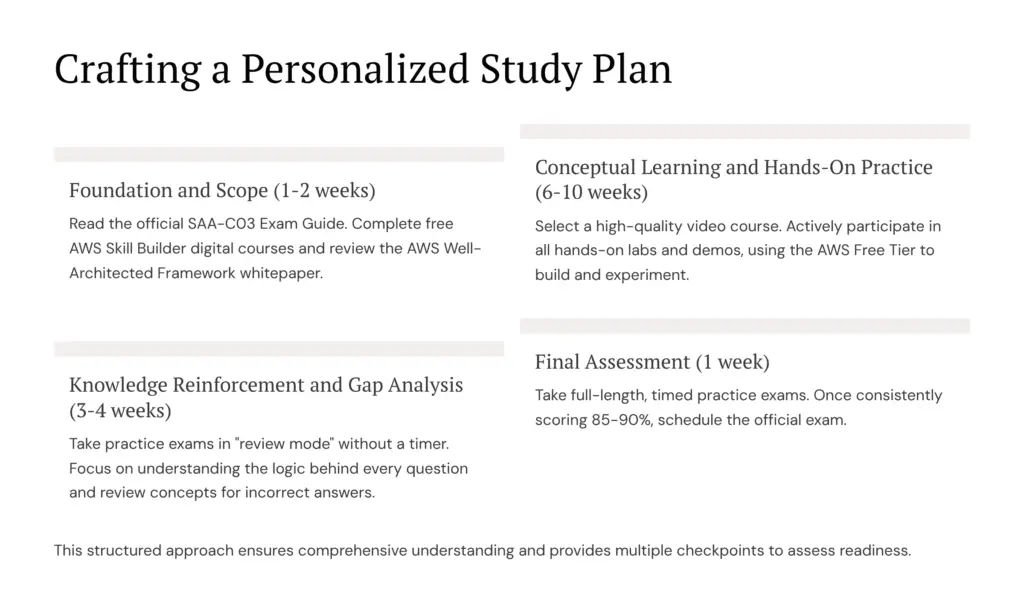
Knowledge Reinforcement and Gap Analysis (3-4 weeks): After completing the course, begin taking practice exams from a top-tier provider like TutorialsDojo. Initially, take them in “review mode” without a timer. Focus on understanding the logic behind every single question. Final Assessment (1 week): In the final week, switch to taking full-length, timed practice exams to simulate the real testing environment. Once you are consistently scoring in the 85-90% range, schedule the official exam.
Recent Updates and What’s Changed
The SAA-C03 represents the latest evolution in AWS’s most popular certification track. Understanding its recent changes helps candidates focus their preparation effectively.
Version Timeline
The original version, SAA-C01, was launched in February 2018. It was succeeded by SAA-C02 on March 23, 2020. The current version, SAA-C03, became available on August 30, 2022. This regular cadence of updates demonstrates a commitment to keeping the certification relevant and aligned with the skills required in the modern cloud landscape.
Current Status and Retirement Schedule
Candidates should note that the SAA-C03 exam may have its retirement announced (date un-known), after which a new version will be introduced. This timeline is a critical factor for anyone planning their study and examination schedule. Current candidates have sufficient time to prepare and test, but shouldn’t delay indefinitely.
Key Changes from Previous Versions
The evolution across these versions reveals a clear trend: an increasing emphasis on security, cost optimization, and resilience, mirroring the maturation of enterprise cloud adoption from experimental projects to business-critical operations. The SAA-C03 specifically increased focus on:
- Advanced security patterns and best practices
- Cost optimization strategies and tools
- Resilience and disaster recovery planning
- Modern application architectures
Service Coverage Updates
The current exam reflects AWS’s expanded service portfolio while maintaining focus on core architectural principles. New services and features receive coverage as they become foundational to modern cloud architecture.
Exam Format Stability
While content evolves, the exam format remains consistent. 65 questions in 130 minutes with multiple choice and multiple response formats provides reliable structure for preparation planning.
How AI is Transforming Solutions Architect Careers

The integration of artificial intelligence into cloud architecture represents both opportunity and evolution for certified professionals. Rather than replacing Solutions Architects, AI enhances their capabilities and shifts their focus toward higher-value activities.
Serverless and AI Convergence
Serverless computing, with AWS Lambda at its core, provides an ideal foundation for modern AI applications. The event-driven, on-demand scaling, and pay-for-what-you-use model of serverless is perfectly suited for the often intermittent and compute-intensive nature of AI workloads like model inference.
Consequently, the modern Solutions Architect is less of an “infrastructure specialist” and more of a “business problem solver.” Their value lies in their ability to design complex, event-driven workflows that integrate managed services like AWS Lambda, Amazon EventBridge, AWS Step Functions, and managed AI platforms like Amazon Bedrock and Amazon SageMaker.
AI as an Architect’s Tool
Furthermore, AI is becoming a powerful tool for architects themselves. AI-powered coding assistants, such as Amazon Q Developer, can now automate routine and complex tasks like generating Infrastructure as Code (IaC) templates or translating configurations between frameworks.
This does not replace the architect but elevates their role. Instead of focusing on the minutiae of syntax, the architect can focus on high-level strategy, validating and refining AI-generated designs, and ensuring that the overall architecture aligns with business goals.
Evolving Skill Requirements
This synergy between human strategic oversight and AI-driven implementation is the future of the role, making “soft skills” like business acumen, creative problem-solving, and communication more critical than ever. Technical expertise remains essential, but the ability to interpret business requirements and guide AI-assisted implementation becomes the differentiator.
Architecture Pattern Changes
Modern architectures increasingly emphasize:
- Event-driven, serverless patterns over traditional server-based designs
- AI-first application development approaches
- Automated infrastructure management and optimization
- Integration of managed AI services with existing enterprise systems
Career Protection Strategies
Certified professionals can future-proof their careers by:
- Developing expertise in serverless architectures and AI service integration
- Learning to work effectively with AI-powered development tools
- Focusing on business outcome-driven architecture design
- Building skills in AI/ML workflow orchestration and optimization
The SAA-C03 certification provides the foundational knowledge needed to navigate this AI-enhanced landscape effectively.
Is AWS Certified Solutions Architect – Associate Worth It in 2025?
Absolutely. The data supports a clear return on investment for dedicated candidates, but success requires realistic expectations and strategic preparation.
Financial Return Analysis
Data from various sources converges on an average annual salary range of approximately $125,000 to $155,000 USD for SAA-C03 holders. With an exam cost of $150 USD and typical preparation investment of $300-500 in study materials, the financial return becomes positive within weeks of employment.
Market Position Strength
Within this large community, the Solutions Architect – Associate certification stands out as the most widely held credential. A survey conducted by Jefferson Frank found that 54% of AWS professionals held this specific certification, placing it far ahead of others like the Cloud Practitioner (37%) and Developer – Associate (25%). This widespread adoption creates network effects and employer recognition.
Hiring Market Reality
In the competitive IT job market, the SAA-C03 certification serves as a powerful and widely recognized signal to hiring managers. An analysis of job descriptions reveals a clear pattern: for entry-level cloud positions, the certification is often listed as a preferred qualification, while for mid-level and senior architect roles, it is frequently a de facto requirement.
However, it is critical to understand that the certification gets a candidate in the door; it is the demonstration of hands-on experience and problem-solving skills that secures the job. The certification creates opportunity; competence converts opportunity into employment.
Industry Growth Context
The U.S. Bureau of Labor Statistics projects that overall employment in computer and information technology occupations will grow significantly faster than the average for all other occupations between 2023 and 2033. The report specifically identifies cloud computing as a key driver of this growth, with roles such as computer network architects being in high demand.
Future-Proofing Considerations
The rise of multi-cloud does not diminish the value of a deep, single-platform certification like the SAA-C03. Given AWS’s continued market leadership, expertise in its ecosystem remains the most in-demand skill set. The SAA-C03 is the cornerstone of an architect’s certification journey, but it should be viewed as the beginning of a path of continuous learning.
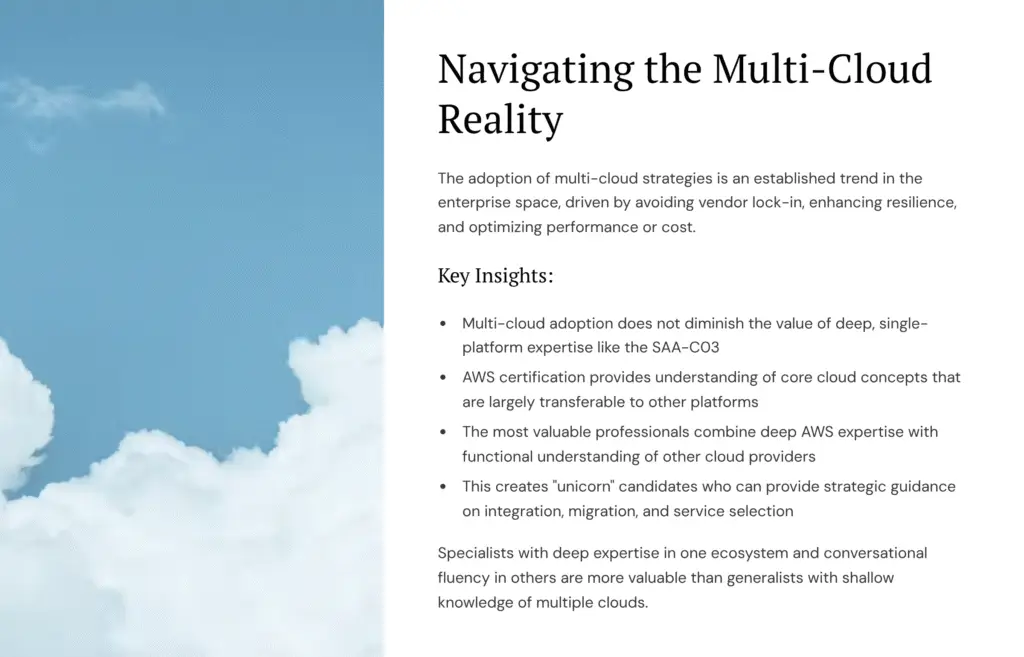
Value Varies by Scenario
The certification provides maximum value for:
- IT professionals transitioning to cloud roles
- Current AWS practitioners seeking formal validation
- Career changers with relevant technical background
- Professionals in organizations adopting cloud-first strategies
Limited value scenarios:
- Professionals with extensive cloud experience but no career advancement goals
- Individuals unwilling to invest in hands-on preparation
- Those seeking immediate employment without additional skill development
Getting Started: Your Next Steps
Ready to pursue the SAA-C03? A systematic approach maximizes your probability of success while minimizing wasted effort.

Step 1: Assess Current Knowledge and Experience
Start with the AWS Skill Builder’s free assessment tools to identify knowledge gaps. Review the official exam guide to understand scope and requirements.
Step 2: Choose Your Study Approach
Select one primary video course based on your learning style and timeline:
- Adrian Cantrill’s course for deep understanding (longer timeline)
- Stéphane Maarek’s Udemy course for exam-focused efficiency (shorter timeline)
Step 3: Create Your Study Plan
Foundation and Scope (1-2 weeks), Conceptual Learning and Hands-On Practice (6-10 weeks), Knowledge Reinforcement and Gap Analysis (3-4 weeks), Final Assessment (1 week). Adjust timing based on your available hours per week and existing background.
Step 4: Invest in Quality Practice Exams
Purchase TutorialsDojo practice exams early in your preparation. Use them to identify weak areas and track progress throughout your study journey.
Step 5: Schedule Your Exam
The SAA-C03 exam may be retired sometime in the near future (speculation). Schedule your exam through AWS Certification when consistently scoring 85-90% on practice exams.
Step 6: Plan Your Next Steps
AWS Certified Solutions Architect – Professional (SAP-C02): This is the most direct and logical next step for anyone on the architecting path. The Professional-level certification validates advanced skills in designing complex, multi-service solutions for large-scale enterprise applications.
Step 7: Develop AI-Enhanced Skills
Begin exploring serverless architectures, AI service integration, and modern application patterns. These skills complement your foundational certification with cutting-edge capabilities.
Success requires commitment to hands-on learning, not just exam preparation. Actively participate in all hands-on labs and demos, using the AWS Free Tier to build, experiment, and break things. This practical application is essential for cementing theoretical knowledge.
The AWS Certified Solutions Architect – Associate (SAA-C03) certification represents a proven pathway to cloud architecture expertise and career advancement. With over 1.05 million unique individuals holding more than 1.42 million active AWS certifications globally, you’ll join a community of professionals who’ve validated their commitment to cloud excellence.
Your success depends on strategic preparation, hands-on practice, and realistic expectations about the time investment required. The certification opens doors, but your competence and continued learning determine what you do with those opportunities.
Start with the official resources, choose quality training materials, and commit to the hands-on experience that transforms knowledge into capability. The cloud architecture career you’re building begins with this foundational step.
Reference Resource List
Official AWS Resources
- AWS Certified Solutions Architect – Associate (SAA-C03) Exam Guide
- AWS Certified Solutions Architect – Associate
- AWS Skill Builder
- AWS Certification FAQs
- Schedule an AWS Certification Exam
Training and Preparation Resources
- AWS Certified Solutions Architect Associate Exam – SAA-C03 Study Path – Tutorials Dojo
- AWS Certified Solutions Architect – Associate (SAA-C03) | learn.cantri – Adrian Cantrill
- AWS Certified Solutions Architect Associate Practice Exams SAA-C03 2025
Salary and Career Research
- The 9 Highest-Paying AWS Certifications and How to Earn Them in 2025 – Skillsoft
- AWS certification in 2024: is it worth it? – Jefferson Frank
- AWS Solutions Architect Roles and Responsibilities – Interview Kickstart
- Computer and Information Technology Occupations – U.S. Bureau of Labor Statistics
Technical and Industry Analysis
- Building serverless architectures for agentic AI on AWS – AWS Prescriptive Guidance
- The career benefits of multicloud fluency | Google Cloud Blog
- Will AI Replace Cloud Architects? The Future of AWS Jobs | by Kamesh
Additional Learning Resources
About Tech Jacks Solutions: We provide comprehensive cybersecurity overview and certification guidance to help professionals advance their careers. Visit our website for more certification guides and training resources.




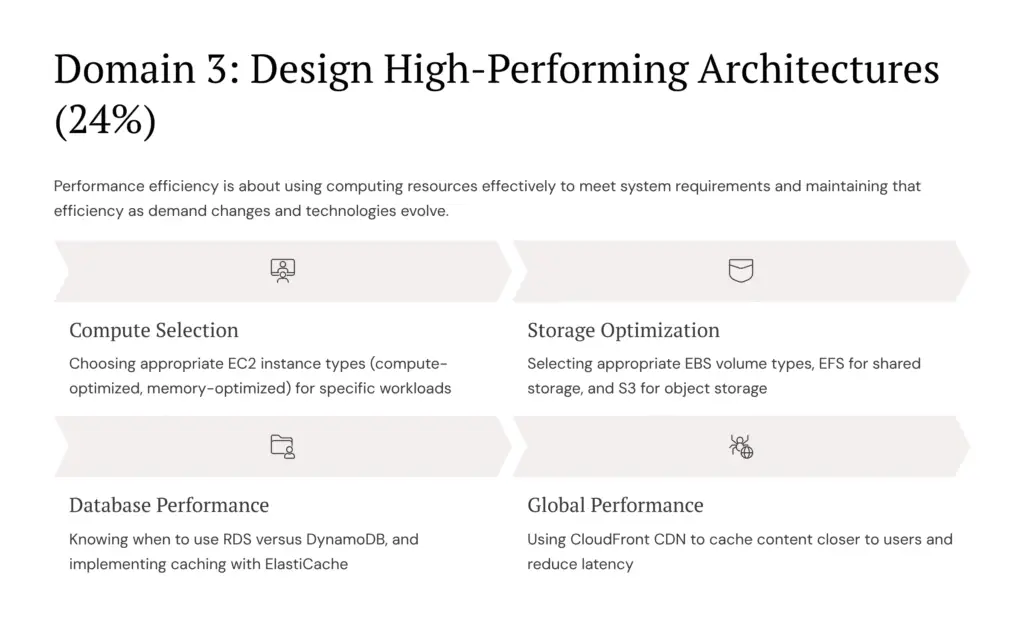


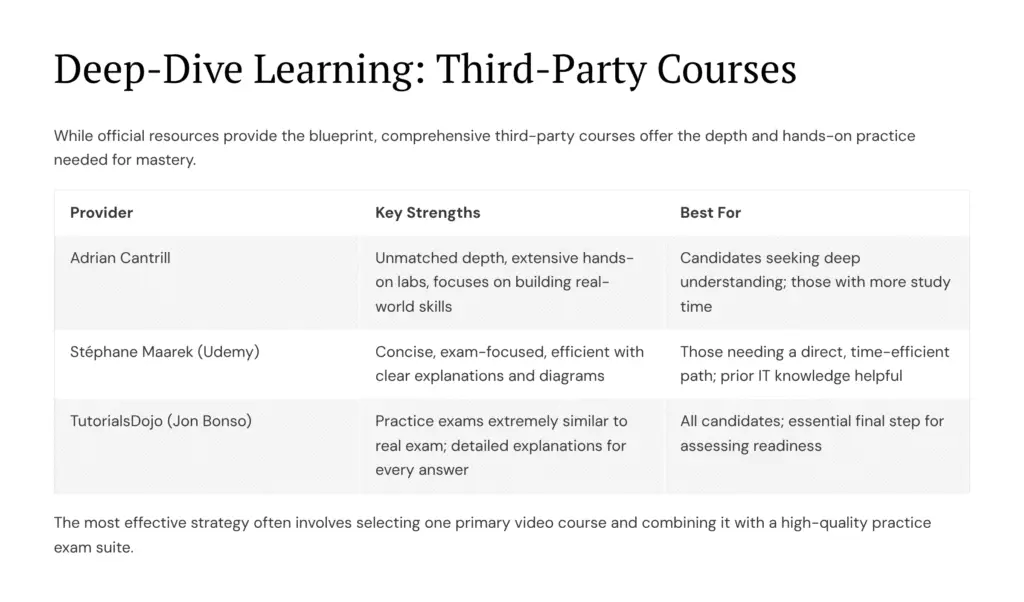

LaTanya Jackson
August 18, 2025This is very nice information